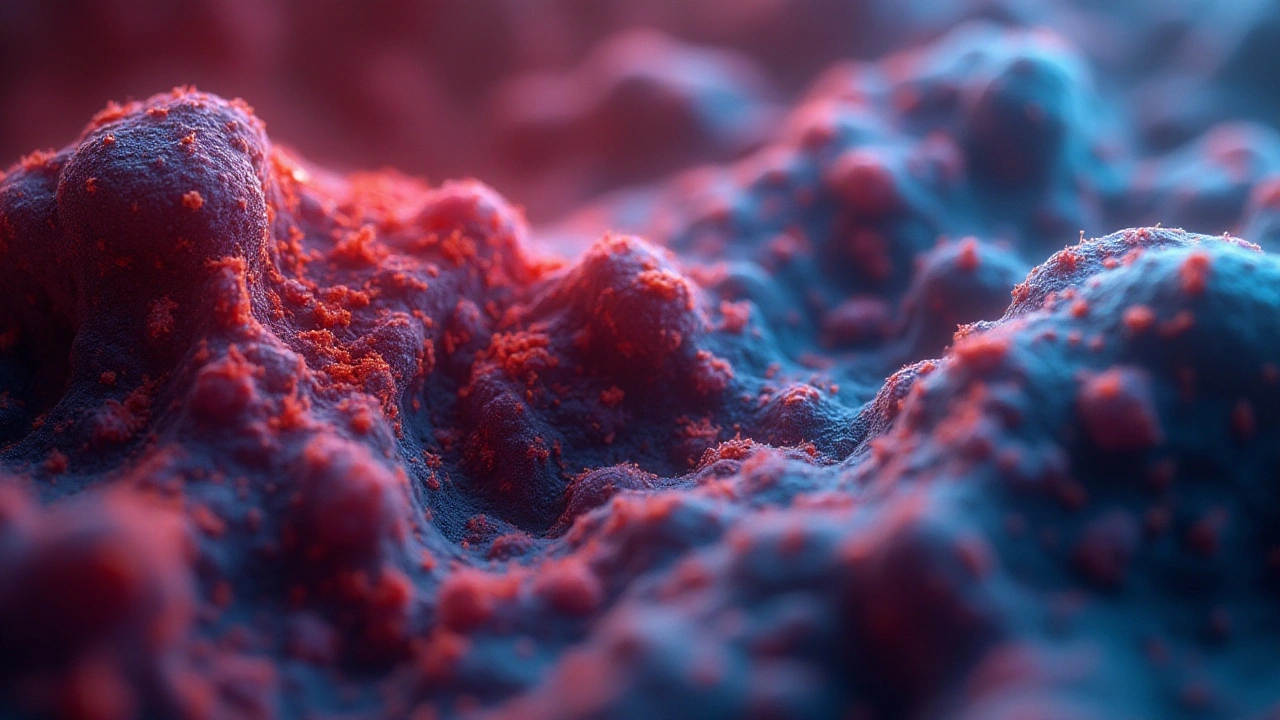When most people think of inflammation, they often picture a scraped knee or a sore throat, that familiar redness and swelling signaling an immune response. But beneath this inflammation lies a complex network of cellular activities, some beneficial and others quite dangerous. Among its more nefarious roles, inflammation can pave the way for tumor growth, a connection that researchers continue to unravel with increasing urgency.
Chronic inflammation creates an environment where cells experience repeated stress, leading to mutations that can encourage tumor growth. The body's persistent immune response to these changes doesn't merely involve a local skirmish; it entwines with the tumor, influencing its trajectory and even aiding its expansion. Understanding these interactions is crucial in the battle against cancer, offering new avenues for treatment and prevention.
- What is Inflammation?
- The Link Between Inflammation and Tumors
- Mechanisms of Tumor Growth via Inflammation
- Immune Response and Tumor Environment
- Potential Therapies Targeting Inflammation
- Lifestyle Changes to Manage Inflammation
What is Inflammation?
Inflammation is an essential part of the body’s defense system. It’s a complex biological response of body tissues to harmful stimuli like pathogens, damaged cells, or irritants. When functioning normally, inflammation helps the body to shield against invading forces or heal injured tissues. This intricate process involves the immune system releasing white blood cells and chemical mediators to the affected area, creating a protective environment where repair can commence. However, inflammation can sometimes become chronic or inappropriate, triggering a cascade of effects on overall health.
From an immunological standpoint, inflammation can be categorized as either acute or chronic. Acute inflammation is short-term and typically presents with a rapid onset following an injury or infection. Its signs include redness, heat, swelling, pain, and loss of function. These symptoms result from increased blood flow and vascular permeability, which allow immune cells to tackle the inciting problem effectively. Chronic inflammation, on the other hand, lingers longer, often persisting for months or years. It can result from persistent infection, prolonged exposure to irritants, or autoimmune disorders where the body mistakenly attacks its own healthy cells.
Chronic inflammation is particularly insidious because it can lead to a range of health issues, including the promotion of tumor growth. This type of inflammation develops when the body's immune response fails to eliminate the root cause of the irritation, or when the response itself causes harm to healthy tissues, creating a vicious cycle of damage and repair. Chronic inflammation can underpin diseases such as arthritis, heart disease, and diabetes, and these conditions often share associations with modern lifestyle factors such as poor diet, stress, and lack of physical activity. This relationship underscores the importance of understanding inflammation's role not just for treating isolated ailments, but for enhancing overall well-being.
Throughout history, notable thinkers have explored inflammation’s dual nature. As the ancient physician Hippocrates wisely observed, "Healing is a matter of time, but it is sometimes also a matter of opportunity." Today, research continues to explore the delicate balance between inflammation’s role as a healer and a potential harbinger of disease. Since inflammation is a double-edged sword, therapeutically targeting it without compromising the immune system's integrity remains a challenge. However, by deciphering its complex mechanisms, we edge closer to unlocking new treatments that can limit its harmful effects while preserving its protective functions.
Recent studies highlight how chronic inflammation modifies the cellular environment in ways conducive to tumorigenesis. For instance, inflammatory cells can produce reactive oxygen species, which damage DNA and promote genetic mutations. Also, inflammatory mediators like cytokines and chemokines can directly support cancer cell proliferation and survival. Tumors, in turn, can exploit these inflammatory pathways to grow and metastasize. This creation of a symbiotic relationship between inflammation and cancer reveals the importance of looking beneath the surface when addressing these diseases.
Intriguingly, data suggests that reducing inflammation through lifestyle modifications could play a crucial role in preventing cancer and other chronic diseases. Interventions such as a balanced diet rich in anti-inflammatory foods, regular exercise, and stress management techniques like meditation or yoga are gaining recognition for their potential in mitigating the inflammatory process. Consequently, understanding inflammation isn't simply an academic pursuit; it is a call to action for embracing approaches that harmonize the body's natural defenses with our modern lifestyles, thereby promoting health and longevity.
The Link Between Inflammation and Tumors
The relationship between inflammation and tumor growth is a complex dance, one that scientists have been observing with growing interest and concern. At its core, inflammation is a biological response that serves to protect the body from infection, injury, or disease. However, when this response becomes chronic, the lingering inflammation can alter the cellular environment. This alteration can create conditions ripe for cancer to thrive. Researchers have discovered that tumors often exploit these inflammatory reactions, using them as a catalyst for tumor development.
Inflammatory cells release a variety of substances such as cytokines and chemokines, which facilitate not only the destruction of harmful pathogens but, inadvertently, can promote mutated cell growth. These toxic cocktails of substances can damage DNA within normal cells, leading to mutations that result in cancer. A prime example of this is evident in colorectal cancer, where chronic inflammatory diseases, such as inflammatory bowel disease, have been linked to an increased risk of developing tumors. "Chronic inflammation creates a pro-carcinogenic environment," notes Dr. Lisa Coussens, a prominent cancer researcher. "It's almost like a silent partner in crime for cancer cells."
There is a growing body of evidence that shows how chronic inflammation acts as a double-edged sword. While aimed at protecting the body, it facilitates mechanisms favorable to tumor growth. During inflammation, vascular permeability increases, allowing immune cells to access damaged tissues. However, this very permeability can also provide cancer cells with greater access to nutrients and oxygen, vital for their proliferation. It's a scenario where the body's own defenses inadvertently aid the enemy.
The Role of Inflammatory Cells
In the tumor environment, inflammatory cells are not just passive bystanders but active participants. They secrete pro-inflammatory cytokines, which can enhance tumor cell survival and proliferation. Immune cells, initially recruited to combat threatening insults, can be co-opted by tumor cells to promote angiogenesis—the formation of new blood vessels—which is crucial for tumor survival and the potential spread to other parts of the body.
Mechanisms of Tumor Growth via Inflammation
The mysterious relationship between inflammation and tumor growth has confounded scientists for decades. It is now understood that chronic inflammation can serve as fertile ground for cancerous activity, reshaping the cellular landscape to favor malignancy. This process typically begins when inflammatory cells are recruited to a site of tissue damage or infection, releasing an array of molecules such as cytokines, chemokines, and growth factors. These molecules, intended to protect and repair, can also alter the genetic material of cells and lead to mutations. Such mutations might deregulate cell division processes, turning once-healthy cells into notorious cancer cells that divide uncontrollably.
One of the primary mechanisms involves the 'reactive oxygen species' (ROS) and 'nitric oxide' (NO) produced by inflammatory cells. These substances are armed with the double-edged sword of destroying pathogens and also causing oxidative damage to DNA. When cellular repair mechanisms falter, these ROS-induced mutations accumulate, setting the stage for the initiation of tumors. Moreover, inflammatory signals can continuously stimulate cell proliferation and inhibit apoptosis, the latter being the natural process of programmed cell death that usually keeps excessive cell growth in check.
Tumor growth is further nurtured in this inflammatory milieu, which disrupts the typical balance between pro-tumor and anti-tumor factors. Angiogenesis, the formation of new blood vessels, is significantly influenced by inflammation, providing tumors with the oxygen and nutrients required to thrive. Vascular endothelial growth factor (VEGF) and other angiogenic factors sourced from inflammatory cells play a pivotal role here, laying the vascular foundation essential for tumor sustenance and expansion.
"Chronic inflammation can act almost like a fertilizer for tumorous growth," states renowned cancer researcher Dr. Lisa Gralinski, emphasizing the often harmful potential of our own immune systems. "Understanding this duality is key to unlocking new cancer therapies that can cut the support lines feeding these rogue cells."
Adding complexity to this narrative is the immune response within the tumor microenvironment, which is itself modulated by the inflammatory process. While the immune system is programmed to attack foreign invaders, in the case of tumors, it sometimes becomes misled, inadvertently supporting rather than combating the cancer. Inhibitory immune checkpoints like PD-1/PD-L1 can be exploited by cancer cells to turn off the body's own defenses, allowing the tumor to evade destruction.
Thus, therapies targeting these inflammatory pathways hold promise, offering a strategic advantage by essentially cutting off the tumor's supply lines. Drugs designed to inhibit cytokines, NF-kB (a protein complex playing a crucial role in inflammation and cell proliferation), and COX-2 are being actively explored. As much as these findings have illuminated our understanding, they've also underscored the complexity of tackling cancer—a multi-faceted beast at the crossroads of genetic predisposition and inflammatory instigation.
Immune Response and Tumor Environment
The interaction between the immune response and the tumor environment forms a fascinating yet paradoxical relationship. Our immune system, initially supposed to act as the body's defense mechanism, sometimes finds itself manipulated by cancer cells, inadvertently aiding their growth and survival. A tumor is not just a collection of cancer cells; it is a dynamic ecosystem that includes immune cells, blood vessels, fibroblasts, and other assorted players. This complex environment can influence both the progression and regression of cancer. When inflammation occurs, immune cells such as macrophages and lymphocytes gather around the tumor, trying to eradicate the harmful cells. Yet, instead of destroying the cancerous invader, chronic inflammation leads to an immune reaction that feeds the tumor, promoting its growth. Scientists refer to this condition as ‘tumor-promoting inflammation’.
Different types of immune cells play various roles within this environment. Tumor-associated macrophages (TAMs), for instance, often exhibit a dual character. While their primary function includes attacking intruders, in the presence of a tumor, these cells can be reprogrammed to assist in tumor growth, supporting chronic inflammation that favors inflammation and cancer progression. Similarly, certain cytokines, which are substances secreted by specific cells of the immune system, can perpetuate tumor presence by stimulating blood vessel growth, providing the tumor with essential nutrients and oxygen. This intricate dance between cellular players in the immune system and those contained within a tumor ensures a persistent cycle where the tumor thrives, even surviving traditional treatments. Understanding these dynamics allows researchers to find ways to break this vicious cycle, identifying therapeutic strategies that can reinstate the immune system's role as the body’s protector.
"Inflammation appears to turn the immune system against the body, aiding the development and survival of tumors. This paradox exemplifies the complexity of cancer biology and paves the pathway for reimagining cancer therapies." - Dr. Lisa Coussens, cancer biologist at Oregon Health & Science University
In addition to macrophages and cytokines, other culprits in this tale include regulatory T-cells and myeloid-derived suppressor cells, which commonly inhabit the tumor microenvironment. These cells harbor immunosuppressive functions, further complicating the immune response by restricting actions that might have eliminated the tumor. This act of evasion showcases tumors not as mere rogue cells multiplying excessively, but as entities that cunningly exploit systemic processes for their propagation. Effective modulation of this environment holds the promise of not only understanding tumor biology but also transforming the course of treatment. Embracing new approaches such as immunotherapy aims to redirect the immune system to target cancer specifically, enhancing our body's innate ability to eliminate malignancies effectively.

Potential Therapies Targeting Inflammation
Inflammation has long been recognized as a natural defense mechanism of the body, but when it goes awry and turns chronic, it can become a double-edged sword, facilitating tumor growth rather than combating it. In recent years, the medical community has turned its attention to developing therapies that aim to modulate this inflammatory response. The goal is to tip the balance in favor of body’s natural defenses without exacerbating the inflammatory processes that might aid in the proliferation of cancer.
One promising area of research involves the use of Non-Steroidal Anti-Inflammatory Drugs (NSAIDs). These drugs, commonly used to relieve pain and reduce inflammation, have shown potential in the suppression of inflammation associated with tumor growth. Studies suggest that aspirin, a well-known NSAID, can significantly lower the risk of certain cancers, including colorectal cancer. These drugs work by inhibiting cyclooxygenase enzymes, which play a pivotal role in the formation of pro-inflammatory compounds. However, NSAIDs are not a one-size-fits-all solution, and their long-term use can lead to unwanted side effects, including gastrointestinal bleeding and cardiovascular issues. Thus, understanding the patient’s profile and disease context is crucial for their effective use.
Cytokine Inhibitors and Their Role
Another avenue being explored is the use of cytokine inhibitors. Cytokines are small proteins released by cells that have a specific effect on communications and interactions between cells. Some of these cytokines drive the inflammatory response and are implicated in promoting tumor growth. Drugs that inhibit cytokines such as IL-6 have shown promise in preclinical trials in slowing down cancer progression. However, devising a therapy that can effectively target and modulate cytokines without impairing the body’s ability to fight infections remains a significant hurdle."The link between inflammation and cancer is becoming increasingly clear, and these therapies represent a hopeful frontier. Balancing efficacy and safety is vital in ensuring these treatments can revolutionize cancer care," remarks Dr. Amanda Ellis from the Cancer Research Institute.
Additionally, recent innovations in immune checkpoint inhibitors are worth noting. These therapies work by taking the brakes off the immune system, allowing it to fight cancer more effectively and potentially overcoming the immune-suppressive environment that chronic inflammation fosters. By specifically targeting checkpoints such as PD-1 and CTLA-4 pathways, these treatments have already shown success in treating certain cancers, such as melanoma and lung cancer, although their exact mechanism in modulating inflammation requires further exploration.
While these therapeutic strategies offer new hope, it’s important to remember that tackling chronic inflammation and cancer is about finding the right balance for each individual patient. The future of chronic inflammation modulation in oncology lies in personalized medicine, where treatments are tailored based on genetic, pathological, and environmental factors. This personalized approach ensures that patients receive the optimal therapeutic strategy that addresses their unique circumstances, maximizing benefits while minimizing risks.
Lifestyle Changes to Manage Inflammation
Living in harmony with our own biology often calls for mindful changes to our daily routines, especially when tackling inflammation, which plays a critical role in supporting tumor growth. A strategic approach to lifestyle can not only curb this invisible foe but also enhance overall health. A balanced diet is widely considered a cornerstone of anti-inflammatory living. Consuming a varied, nutrient-rich diet helps in reducing chronic inflammation. Foods rich in omega-3 fatty acids, like salmon and walnuts, have shown promise in reducing inflammation. The emphasis on leafy greens, berries, and whole grains remains not just timeless but scientifically advantageous. Incorporating colorful fruits and vegetables ensures a robust intake of antioxidants, which fight harmful free radicals linked to inflammatory processes. Probiotic-rich foods, such as yogurt and kefir, support gut health, which often signals the overall status of inflammation in the body.
Physical Activity and Its Effects
Equally significant is physical activity which, beyond its cardioprotective benefits, plays an undeniable role in reducing inflammation levels. Engaging in regular exercise helps regulate the immune system's response, ensuring that inflammation doesn't spiral into chronic territory. Aerobic exercises, like walking, cycling, or swimming, can be particularly effective. Recent studies suggest that even modest daily activity—such as walking for thirty minutes—can yield substantial anti-inflammatory benefits. The focus should be on maintaining consistency rather than intensity, promoting long-term adherence. A notable study highlights that individuals dedicated to moderate physical activities tend to exhibit lower markers of inflammation than their sedentary counterparts, underscoring the value of movement.
"The strongest weapon against stress resides in our ability to choose one thought over another." - William James
Stress Management and Sleep Hygiene
Stress, albeit an inevitable aspect of life, when unmanaged, can significantly contribute to the body's inflammatory state. Practices like yoga, mindfulness, and meditation serve as potent tools in managing stress. By calming the mind, these techniques can notably decrease the release of stress hormones, which are often linked to escalated inflammatory markers. Alongside stress management, prioritizing quality sleep is paramount. During sleep, the body executes crucial repair processes, balancing hormones responsible for inflammation. Ensuring seven to nine hours of undisturbed rest can prove transformative. Substantial research associates poor sleep patterns with heightened inflammation, suggesting that fostering a good sleep environment—dark, cool, and device-free—can make a notable difference.
Smoking, Alcohol, and their Impact
Another pivotal lifestyle consideration relates to smoking and alcohol consumption. Both are known catalysts for inflammatory responses within the body. Cigarettes contain numerous toxins that directly lead to systemic inflammation. Consequently, cessation greatly diminishes these effects, with positive impacts felt almost immediately. While moderate alcohol consumption may offer some health benefits, excessive drinking conversely promotes a pro-inflammatory state. Choosing moderation, perhaps substituting a casual drink with a hydrating alternative like green tea, could impart substantial anti-inflammatory benefits. It’s essential to remember that these lifestyle shifts are cumulative, meaning that the overall adoption of healthier habits over time tends to compound positively, efficiently turning the tide against ever-looming chronic inflammation. Consistency and commitment to these lifestyle adjustments lay down a solid foundation, offering a promising horizon where inflammation no longer reigns unchecked.



Comments (20)
Zach Harrison
Man, I never thought about how inflammation could be helping tumors grow. I always just figured it was the body trying to fix stuff. This post actually made me rethink my whole diet. Maybe I should cut out the junk food for real this time.
M. Kyle Moseby
This is why we need to stop letting doctors pump us full of pills. Inflammation isn't the enemy - laziness and sugar are. If you ate right and moved your body, you wouldn't need all this fancy science.
Terri-Anne Whitehouse
How quaint. You're all acting like this is some groundbreaking revelation. The link between chronic inflammation and carcinogenesis has been peer-reviewed since the early 2000s. Did you really need a 2000-word blog post to realize that your diet affects your cells? How endearing.
Matthew Williams
Oh great, another liberal science article pretending inflammation is bad. You know what causes real inflammation? Illegal immigration, woke policies, and people who think vaccines are optional. This whole post is just another way to scare you into buying organic kale. Wake up, sheeple.
Dave Collins
Wow. A 12-section essay on inflammation. I'm sure Dr. Google will be thrilled. Next up: 'The Shocking Truth About Oxygen - It's Probably Causing Your Cancer Too.' 🙄
Idolla Leboeuf
Change your life. Eat clean. Move daily. Sleep like your life depends on it. It does. You got this. 💪
Cole Brown
This is really helpful. I’ve been trying to cut down on sugar, and now I see why. It’s not just about weight - it’s about my body not attacking itself. Thank you for explaining this so clearly. I’ll stick with the veggies and walks.
Danny Pohflepp
Let us not ignore the geopolitical implications of this data. The WHO has been suppressing evidence linking chronic inflammation to engineered pathogens since 2016. The pharmaceutical industry profits from the illusion of 'treatment' while ignoring root causes. This article, while technically accurate, omits the systemic manipulation of public health narratives. Consider the source. And the funding. And the patents.
Halona Patrick Shaw
I mean... I’ve had psoriasis since I was 12. My skin’s been on fire for 20 years. And yeah - I got colon cancer last year. Coincidence? Nah. My body was screaming. I just didn’t know how to listen. This post? It felt like someone finally turned the volume down on the noise.
Elizabeth Nikole
so like... if i stop eating bread, does that mean i won't get cancer?? 😭😭😭
LeAnn Raschke
I love how this breaks it down so simply. I showed this to my mom - she’s 72 and has arthritis. She said, 'So that’s why my knees hurt so bad after church potlucks.' We’re switching to salmon and broccoli now. Thanks for the clarity!
Adorable William
Interesting. But have you considered that the entire 'inflammation-cancer' narrative was designed by Big Pharma to sell COX-2 inhibitors? The real cause is glyphosate in your water. The EPA knew. The FDA knew. And now you’re all just playing along with the narrative. I’ve been drinking distilled water and taking colloidal silver since 2018. My CRP levels are undetectable. You’re welcome.
Suresh Patil
Back home in India, we’ve always known this. Turmeric in milk. Ginger tea. No sugar. No processed food. Our grandmothers didn’t need journals or studies - they knew their bodies. Maybe we should listen to tradition before we invent new drugs.
Ram Babu S
Small steps matter. I started walking 20 minutes after dinner. After 3 months, my joint pain dropped. Not because of pills - because I moved. You don’t need a PhD to heal your body. Just consistency.
Kyle Buck
While the article presents a compelling phenomenological overview of the tumor-promoting inflammatory microenvironment, it lacks rigorous engagement with the molecular epistemic framework underpinning NF-κB-mediated transcriptional reprogramming of tumor-associated macrophages. Furthermore, the omission of TGF-β signaling dynamics and its crosstalk with IL-17 in the tumor stroma represents a significant lacuna in the mechanistic exposition. A more granular analysis of checkpoint ligand expression kinetics would have elevated the discourse beyond popular science exposition.
Amy Craine
This is so important. I work with cancer patients, and I see how many of them are terrified of their own bodies. This post helps reframe inflammation not as a failure, but as a signal. We can work with it - not against it. That’s hope.
Alicia Buchter
Ugh. Another 'eat kale and meditate' post. Like, I have a 60-hour workweek, two kids, and a dog that throws up on the rug daily. You think I have time to juice turmeric? Give me a break.
MaKayla VanMeter
so like... if i stop being angry, will my tumors disappear?? 😔🔥
Doug Pikul
Man, I used to think this stuff was all hype. Then my buddy got diagnosed with stage 3 colon cancer. He changed his diet, started walking, cut out alcohol - and now? He’s in remission. No chemo. Just food, sleep, and movement. This isn’t magic. It’s biology. And it’s real.
anthony perry
Chronic inflammation = slow burn. Tumors = fire. Same fuel.